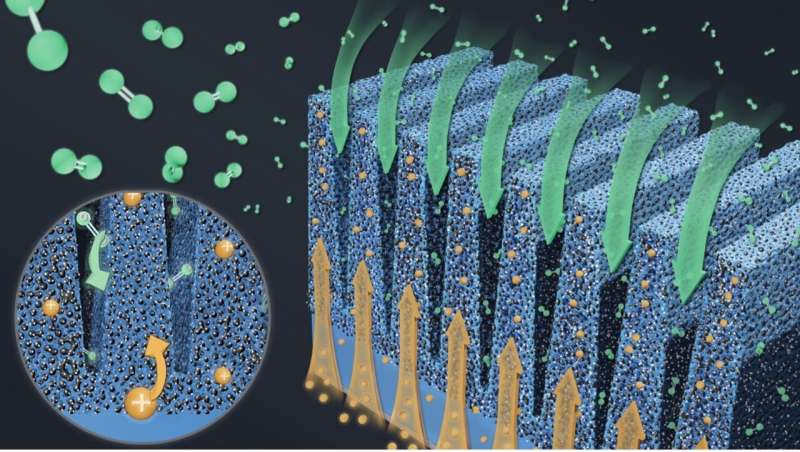Grooved electrodes could improve the performance of proton-exchange membrane fuel cells

Proton-exchange membrane fuel cells (PEMFCs) are a promising energy solution for reducing carbon emissions in the transport sector. As suggested by their name, these cells contain a proton-conducting membrane based on polymer materials that serves as an electrolyte. While PEMFCs could have notable advantages, their cost, durability and the availability of the fuel required to operate them will need to improve before they can be implemented on a large-scale.
Researchers at Los Alamos National Laboratory recently developed new electrodes that could significantly improve the performance and durability of PEMFCs. These electrodes, introduced in Nature Energy, have a characteristic grooved conformation that can facilitate the transport of both oxygen and protons in the fuel cells.
“We knew that the performance of conventional electrodes was limited by transport of species such as oxygen and protons, and we were inspired by the historic work of our colleagues at LANL in the 1990s, who discovered how to combine a carbon-supported platinum catalyst with proton-conducting ionomer to achieve major performance improvements,” Jacob Spendelow, one of the researchers who carried out the study, told Tech Xplore.
“It’s a bit surprising that, 30 years later, state-of-the-art electrodes still use essentially the same structure. We thus set out to redesign the structure by using a rational design approach to expedite both oxygen and proton transport.”
The grooved electrodes designed by Spendelow and his colleagues have numerous microscale ridges, which essentially consist of a carbon-supported platinum catalyst separated by empty indentations. Due to their unique configuration, they can partition the transport of oxygen and protons into different parts of their structure.
“Conventional electrodes require mixed transport of oxygen and protons through all parts of the electrode, which requires some design compromises, since the proton-conducting ionomer obstructs transport of oxygen,” Spendelow explained. “In contrast, by separating the oxygen and proton transport, the grooved electrode design allows parts of the electrode (the grooves) to be optimized for oxygen transport, while other parts (the ridges) are optimized for proton transport. This ‘divide and conquer’ approach enables faster transport and higher performance.”
The researchers evaluated their grooved electrodes in a series of tests run at standard operating conditions for fuel cells. They found that their performance was up to 50% better than that of conventional electrodes, and that they could facilitate the transport of oxygen and improve the uniformity of chemical reactions. In addition, the grooved electrodes appeared to be more durable than their conventional counterparts, as their performance did not decline as much after a carbon corrosion test.
“Most of the research on improving fuel cell performance and durability focuses on the development of new materials,” Spendelow said. “New materials are certainly helpful, but our work demonstrates that electrode structure is equally important. We hope that other researchers will be inspired by these results to pursue further advances in fuel cells and related devices through development of improved electrode designs.”
The initial findings gathered by this team of researchers are highly promising, suggesting that grooved electrodes could help to significantly improve both the performance and durability of PEMFCs, while also potentially reducing their size and fabrication costs. Their recent work is merely a proof of concept, however, as the microfabrication used to create their prototypes would be difficult to apply on a larger scale.
“Further work on roll-to-roll production of the grooved electrode structure is needed to move this concept from the lab to the manufacturing line,” Spendelow added. “At the same time, we’re also pursuing some other ideas on rational electrode design in an attempt to develop new electrode architectures with performance and durability even higher than that of the grooved electrode.”
More information:
ChungHyuk Lee et al, Grooved electrodes for high-power-density fuel cells, Nature Energy (2023). DOI: 10.1038/s41560-023-01263-2
© 2023 Science X Network
Citation:
Grooved electrodes could improve the performance of proton-exchange membrane fuel cells (2023, July 4)
retrieved 4 July 2023
from https://techxplore.com/news/2023-07-grooved-electrodes-proton-exchange-membrane-fuel.html
This document is subject to copyright. Apart from any fair dealing for the purpose of private study or research, no
part may be reproduced without the written permission. The content is provided for information purposes only.
For all the latest Technology News Click Here
For the latest news and updates, follow us on Google News.

